2023届高三英语二轮复习:冠词讲解课件(18张ppt)-
文档属性
| 名称 | 2023届高三英语二轮复习:冠词讲解课件(18张ppt)- | 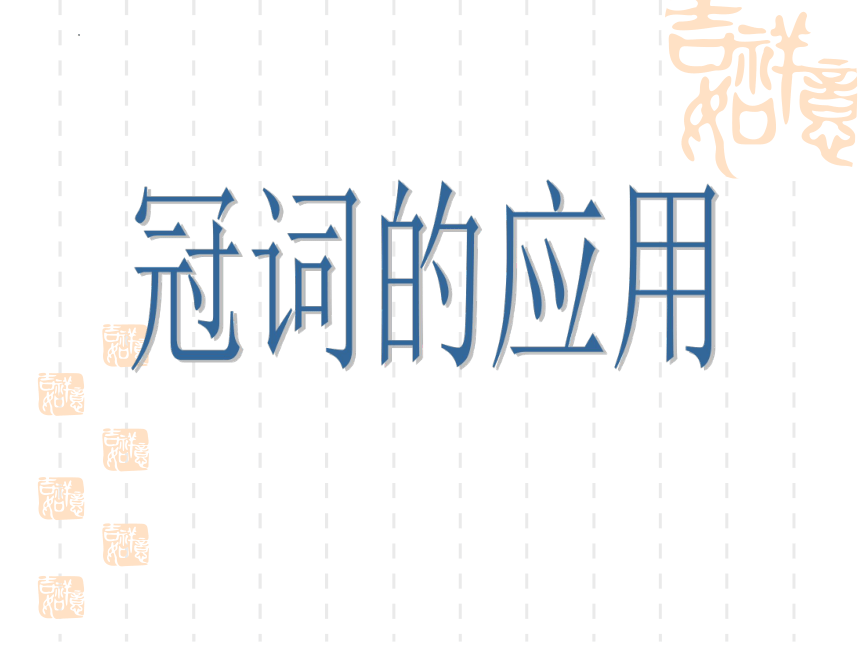 | |
| 格式 | pptx | ||
| 文件大小 | 224.6KB | ||
| 资源类型 | 教案 | ||
| 版本资源 | 通用版 | ||
| 科目 | 英语 | ||
| 更新时间 | 2022-09-18 23:39:18 | ||
图片预览

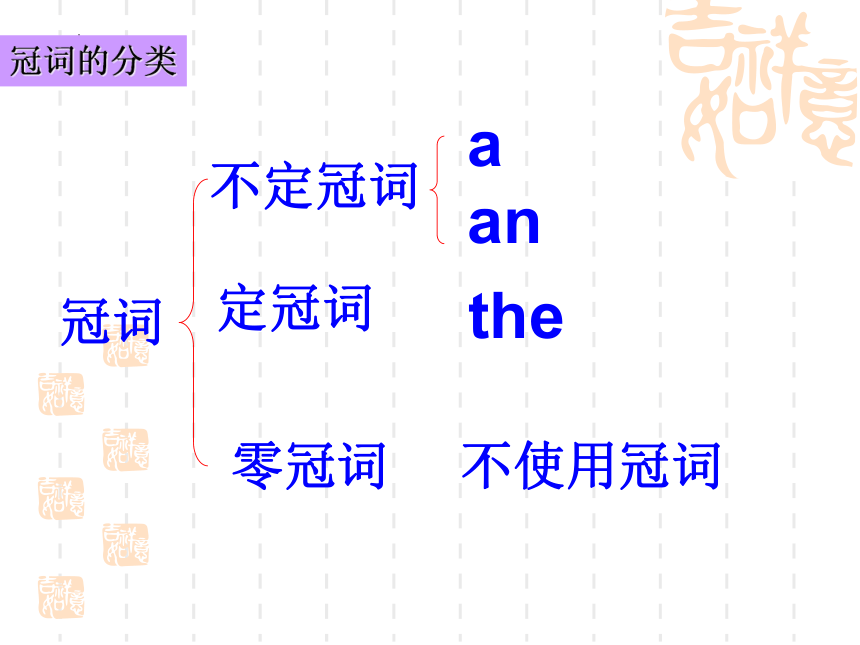
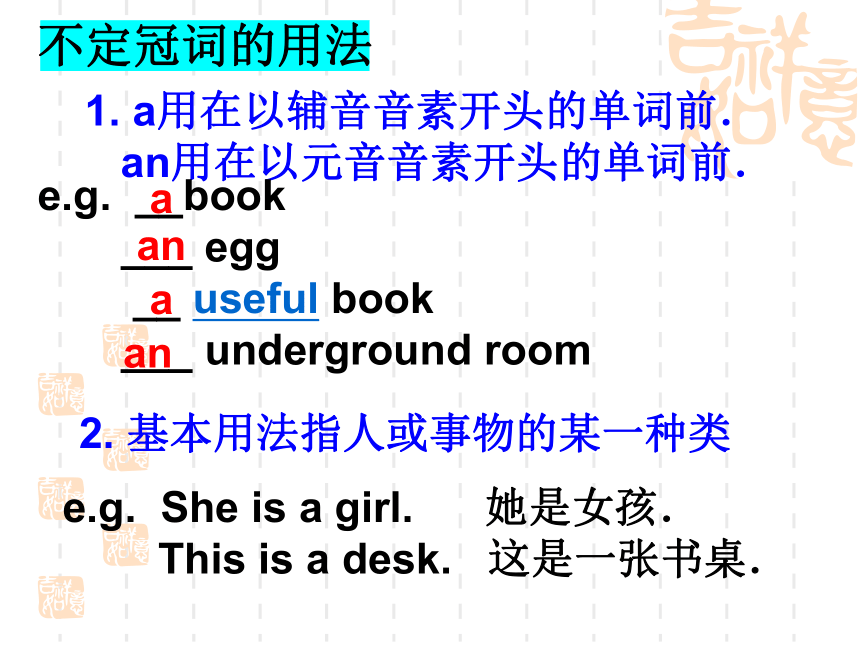
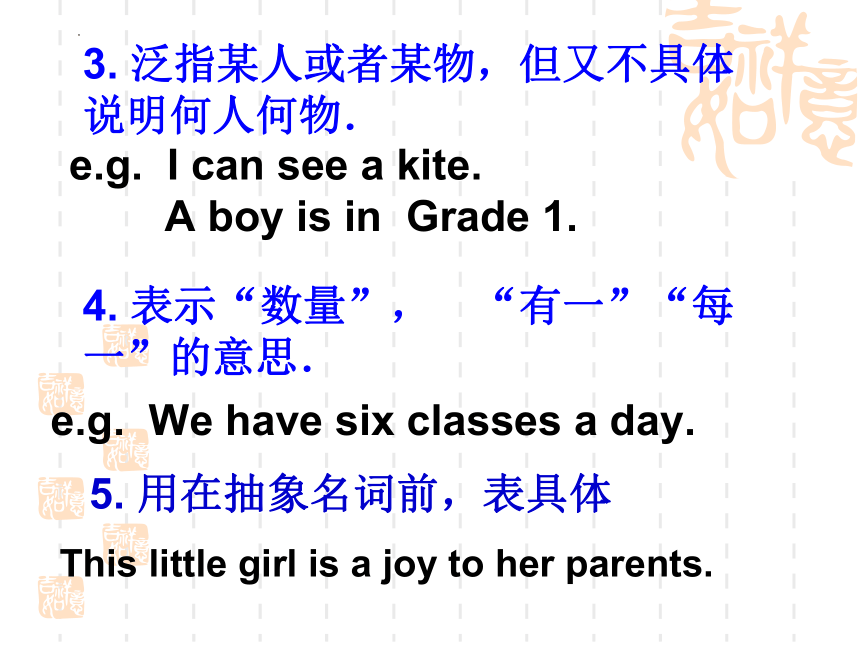
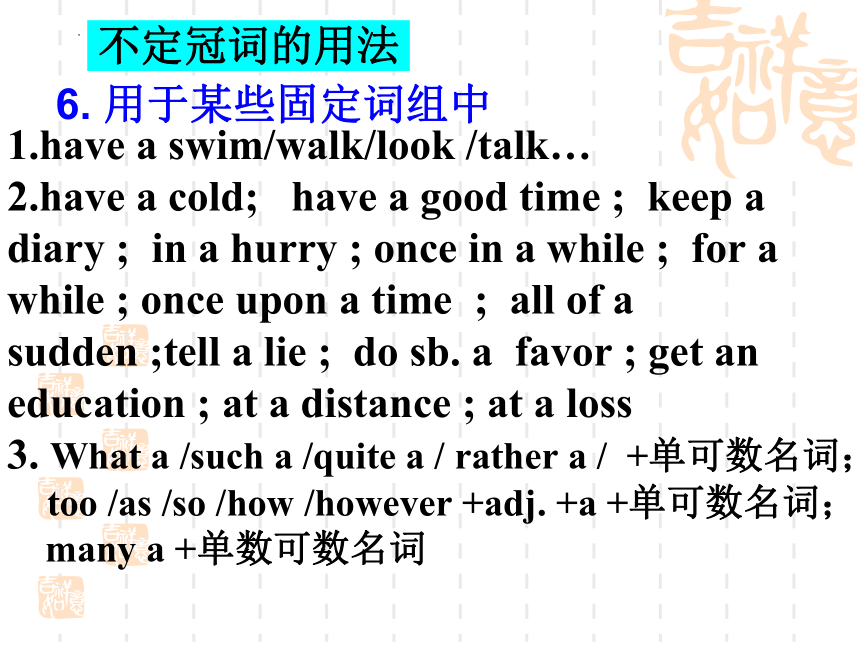
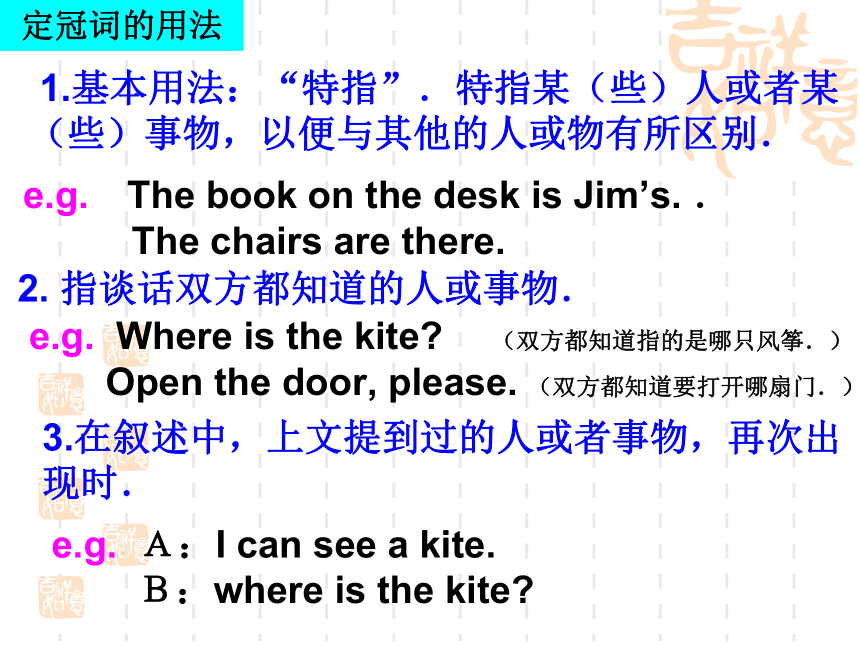
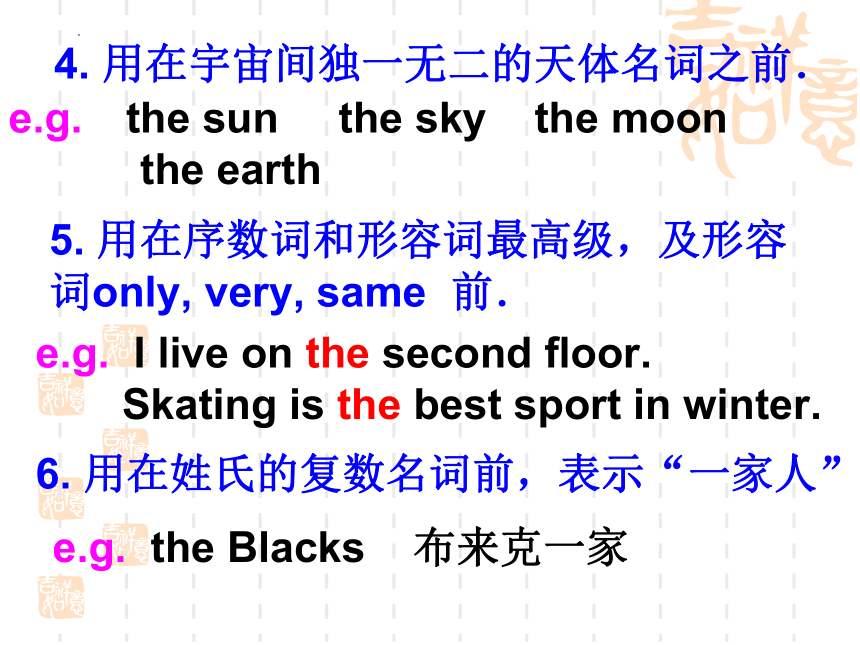
文档简介
(共18张PPT)
冠词的应用
冠词
不使用冠词
定冠词
不定冠词
a
an
the
零冠词
冠词的分类
不定冠词的用法
1. a用在以辅音音素开头的单词前.
an用在以元音音素开头的单词前.
e.g. __book
___ egg
__ useful book
___ underground room
a
an
a
an
2. 基本用法指人或事物的某一种类
e.g. She is a girl. 她是女孩.
This is a desk. 这是一张书桌.
3. 泛指某人或者某物,但又不具体说明何人何物.
e.g. I can see a kite.
A boy is in Grade 1.
4. 表示“数量”, “有一”“每一”的意思.
e.g. We have six classes a day.
5. 用在抽象名词前,表具体
This little girl is a joy to her parents.
不定冠词的用法
6. 用于某些固定词组中
1.have a swim/walk/look /talk…
2.have a cold; have a good time ; keep a diary ; in a hurry ; once in a while ; for a while ; once upon a time ; all of a sudden ;tell a lie ; do sb. a favor ; get an education ; at a distance ; at a loss
3. What a /such a /quite a / rather a / +单可数名词;
too /as /so /how /however +adj. +a +单可数名词;
many a +单数可数名词
定冠词的用法
1.基本用法:“特指”.特指某(些)人或者某(些)事物,以便与其他的人或物有所区别.
e.g. The book on the desk is Jim’s. .
The chairs are there.
2. 指谈话双方都知道的人或事物.
e.g. Where is the kite (双方都知道指的是哪只风筝.)
Open the door, please. (双方都知道要打开哪扇门.)
3.在叙述中,上文提到过的人或者事物,再次出现时.
e.g. A:I can see a kite.
B:where is the kite
6. 用在姓氏的复数名词前,表示“一家人”
e.g. the Blacks 布来克一家
4. 用在宇宙间独一无二的天体名词之前.
e.g. the sun the sky the moon
the earth
5. 用在序数词和形容词最高级,及形容词only, very, same 前.
e.g. I live on the second floor.
Skating is the best sport in winter.
定冠词的用法
7. 用在某些建筑物和旅馆的名称之前.
The Palace Museum The Summer Palace
8. 用在表示乐器的名词之前.
e.g. the violin the piano
9. 用在一些习惯用语中
e.g. in the day
in the morning / aftrnoon/ evening
the day before tomorrow/ yesterday
10. 用在普通名词构成的专有名词前。
We want to see the Great wall with our own eyes.
定冠词的用法
12. 用在表示海洋、河流、山脉、群岛、海湾等专有名词前。
the Atlantic Ocean
the Yellow river
the Alps
11. 用在形容词前,表示一类人。
The poor, the wounded, the dead, the rich
定冠词的用法
独一无二最高级,江河湖海和乐器,
阶级党团和报纸,还有组织和杂志,
说过的人或者事,同一东西大家知,
姓氏前指一家人,序数词前表第几。
零冠词的用法
1.名词前有了物主代词、指示代词、不定代词和“S”所有格时。
e.g. Our books those apples Jim’s pen
2.复数名词在表示一类人或者事物时。
e.g. They are teachers.
3.在专有名词前
e.g. China England
4.在星期、月份、节日前
e.g. on Sunday in August
on Children’s Day
不使用冠词的情况
冠
词
的
分
类
零冠词的用法
5. 在球类运动前及三餐名词前。
e.g. play football/ basketball
have supper
6. 在一些固定搭配中
e.g.
at night go to school
at table by bike
at work go to bed
at school watch TV
at home
零冠词的用法
7. 科目前不加
e.g. We learn Chinese,maths English.
8. 在称呼语或表示头衔的名称前。
e.g. What’s the matter,granny
We elected him monitor.
季节、月份和星期,节日、三餐和泛指;
语言、学科、称呼语,头衔、职位和球棋.
动词(hit, pull, pat, strike(打), catch, hold, take)
+sb. +介词(in, on, by)+ the+身体部位
She touched him on the shoulder.
她碰了碰他的肩。
The stone struck the man in the eye.
石头击中了那人的眼睛。
I caught her by the right hand.
我抓住她的右手。
她拍了拍那男孩的头。
She patted the boy on the head.
有定冠词与无定冠词的区别
in front of 在…前面
in the front of 在…范围内的前部
in hospital 住院
in the hospital 在医院
in prison 坐牢
in the prison 在监狱
in charge of …负责…
in the charge of 由…负责
in place of 代替
in the place of 在… 的地方
at church 做礼拜
at the church 在教堂
at table吃饭
at the table在桌子旁
by day 在白天
by the day 按日
take place 发生
take the place of 代替
on earth在世上, 究竟
on the earth在地球上
out of question = beyond question
毫无疑问
out of the question 不可能
例子
a useful tool
一件有用的工具
a university
一所大学
a European country
一个欧洲国家
a one-eyed man
一个一目失明的人
a D [di:] 一个D
B、C、G、J、K、P、Q、T、U、V、W、Y、Z
an F [ef] 一个F
A、E、H、I、L、M、N、O、R、S、X
冠词的应用
冠词
不使用冠词
定冠词
不定冠词
a
an
the
零冠词
冠词的分类
不定冠词的用法
1. a用在以辅音音素开头的单词前.
an用在以元音音素开头的单词前.
e.g. __book
___ egg
__ useful book
___ underground room
a
an
a
an
2. 基本用法指人或事物的某一种类
e.g. She is a girl. 她是女孩.
This is a desk. 这是一张书桌.
3. 泛指某人或者某物,但又不具体说明何人何物.
e.g. I can see a kite.
A boy is in Grade 1.
4. 表示“数量”, “有一”“每一”的意思.
e.g. We have six classes a day.
5. 用在抽象名词前,表具体
This little girl is a joy to her parents.
不定冠词的用法
6. 用于某些固定词组中
1.have a swim/walk/look /talk…
2.have a cold; have a good time ; keep a diary ; in a hurry ; once in a while ; for a while ; once upon a time ; all of a sudden ;tell a lie ; do sb. a favor ; get an education ; at a distance ; at a loss
3. What a /such a /quite a / rather a / +单可数名词;
too /as /so /how /however +adj. +a +单可数名词;
many a +单数可数名词
定冠词的用法
1.基本用法:“特指”.特指某(些)人或者某(些)事物,以便与其他的人或物有所区别.
e.g. The book on the desk is Jim’s. .
The chairs are there.
2. 指谈话双方都知道的人或事物.
e.g. Where is the kite (双方都知道指的是哪只风筝.)
Open the door, please. (双方都知道要打开哪扇门.)
3.在叙述中,上文提到过的人或者事物,再次出现时.
e.g. A:I can see a kite.
B:where is the kite
6. 用在姓氏的复数名词前,表示“一家人”
e.g. the Blacks 布来克一家
4. 用在宇宙间独一无二的天体名词之前.
e.g. the sun the sky the moon
the earth
5. 用在序数词和形容词最高级,及形容词only, very, same 前.
e.g. I live on the second floor.
Skating is the best sport in winter.
定冠词的用法
7. 用在某些建筑物和旅馆的名称之前.
The Palace Museum The Summer Palace
8. 用在表示乐器的名词之前.
e.g. the violin the piano
9. 用在一些习惯用语中
e.g. in the day
in the morning / aftrnoon/ evening
the day before tomorrow/ yesterday
10. 用在普通名词构成的专有名词前。
We want to see the Great wall with our own eyes.
定冠词的用法
12. 用在表示海洋、河流、山脉、群岛、海湾等专有名词前。
the Atlantic Ocean
the Yellow river
the Alps
11. 用在形容词前,表示一类人。
The poor, the wounded, the dead, the rich
定冠词的用法
独一无二最高级,江河湖海和乐器,
阶级党团和报纸,还有组织和杂志,
说过的人或者事,同一东西大家知,
姓氏前指一家人,序数词前表第几。
零冠词的用法
1.名词前有了物主代词、指示代词、不定代词和“S”所有格时。
e.g. Our books those apples Jim’s pen
2.复数名词在表示一类人或者事物时。
e.g. They are teachers.
3.在专有名词前
e.g. China England
4.在星期、月份、节日前
e.g. on Sunday in August
on Children’s Day
不使用冠词的情况
冠
词
的
分
类
零冠词的用法
5. 在球类运动前及三餐名词前。
e.g. play football/ basketball
have supper
6. 在一些固定搭配中
e.g.
at night go to school
at table by bike
at work go to bed
at school watch TV
at home
零冠词的用法
7. 科目前不加
e.g. We learn Chinese,maths English.
8. 在称呼语或表示头衔的名称前。
e.g. What’s the matter,granny
We elected him monitor.
季节、月份和星期,节日、三餐和泛指;
语言、学科、称呼语,头衔、职位和球棋.
动词(hit, pull, pat, strike(打), catch, hold, take)
+sb. +介词(in, on, by)+ the+身体部位
She touched him on the shoulder.
她碰了碰他的肩。
The stone struck the man in the eye.
石头击中了那人的眼睛。
I caught her by the right hand.
我抓住她的右手。
她拍了拍那男孩的头。
She patted the boy on the head.
有定冠词与无定冠词的区别
in front of 在…前面
in the front of 在…范围内的前部
in hospital 住院
in the hospital 在医院
in prison 坐牢
in the prison 在监狱
in charge of …负责…
in the charge of 由…负责
in place of 代替
in the place of 在… 的地方
at church 做礼拜
at the church 在教堂
at table吃饭
at the table在桌子旁
by day 在白天
by the day 按日
take place 发生
take the place of 代替
on earth在世上, 究竟
on the earth在地球上
out of question = beyond question
毫无疑问
out of the question 不可能
例子
a useful tool
一件有用的工具
a university
一所大学
a European country
一个欧洲国家
a one-eyed man
一个一目失明的人
a D [di:] 一个D
B、C、G、J、K、P、Q、T、U、V、W、Y、Z
an F [ef] 一个F
A、E、H、I、L、M、N、O、R、S、X
